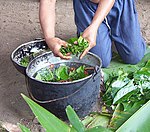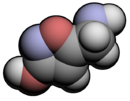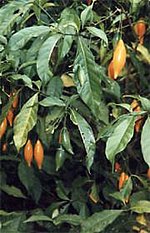archive drugs entheogens geek list lsd medicine nature plants psychedelics psycho-active religion science trippinballs
List of entheogens
From Wikipedia, the free encyclopedia
This is a partial list of entheogenic substances:
| Entheogenic substance | Naturally occurring | Effects |
|---|---|---|

|
 Psychotria viridis; Mimosa hostilis ; Diplopterys cabrerana; Reed canary grass ;Harding grass Psychotria viridis; Mimosa hostilis ; Diplopterys cabrerana; Reed canary grass ;Harding grass |
If DMT is smoked, injected, or orally ingested with an MAOI, it can produce powerful entheogenic experiences including true hallucinations (perceived extensions of reality). Contact with alien beings is often reported. |

|

|
At high doses the effects become more powerful and may additionally include reports of perceptions of dimensional distortion, vertigo, feelings of intense exhilaration and/or panic, sensations of wind or physical pressure, hearing voices, flanging of sound, significant open and closed-eye visuals, loss of speech, life changing experiences, dissociation and various experiences of alternate realities, out-of-body experiences, visiting parallel universes, dissolution of one's ego (Ego Death), as well as perceived contact with beings or entities (some encounter a "Salvia Goddess", but others report contact with neither feminine nor masculine forces at all, but something which possesses no distinguishing sex, or attributes of both sexes.). Salvia extract may be smoked on the dried leaves or pure liquid extract ingested, with most experiences lasting only a brief period of time. |

|

|
Users typically experience visual hallucinations and radically altered states of consciousness, often experienced as pleasurable and illuminating but occasionally as accompanied by feelings of anxiety or revulsion |

|

Psilocybe cubensis; Psilocybe cyanescens; Psilocybe semilanceata; Gymnopilus junonius |
The effects of psilocybin (converted to active psilocin in human body) are often pleasant, even ecstatic, including a deep sense of connection to others, confusion, hilarity, and a general feeling of connection to nature and the universe. |

|

|
The effects of muscimol are substantially different from psilocybin, as the chemicals target separate parts of the brain. Muscimol has been shown to lack "structured" hallucinations in most cases, and the effects are frequently compared to a lucid dream state. |

|

|
At low doses, ibogaine has a mild stimulant effect. At higher doses, temporary effects include hallucination and ataxia. The most studied long-term therapeutic effect is that ibogaine seems to catalyze partial or complete interruption of addiction to opioids and possibly other addictive drugs. |

|

Seeds of Anadenanthera colubrina |
Bufotenin is the primary active constituent of the beans of Anadenanthera colubrina and Anadenanthera peregrina trees. The snuffs known as Vilca and Yopo (or Cohoba) are made from the beans of these trees. To improve the snuff's potency, most shamans usually add a natural form of calcium hydroxide (or calcium oxide) and a little water to the snuff. This processing with calcium hydroxide causes the bufotenin present in the beans to convert to calcium bufotenate (a lipid soluble derivative of bufotenin with stronger hallucinogenic effects than the form naturally present in the beans). A typical dose of snuff contains over 100 mg of bufotenin (as the calcium salt). |

|

|
The onset of effects occurs in seconds after smoking/injecting, or minutes after insufflating, and the experience is sometimes described as similar to a near-death experience or being in "the void". |

Tetrahydrocannabinol (THC) |

|
THC is the primary active constituent of the various forms of cannabis, psychoactive preparations of Cannabis sativa, though other cannabinoids are present and play a role in the effects of the drug. Cannabis has an ancient history of ritual usage. In India, it has been engaged by itinerant sadhus for centuries, and in modern times the Rastafari movement has embraced it. Some historians and etymologists have claimed that cannabis was used as a religious sacrament by ancient Jews, early Christians and Muslims of the Sufi order. See Spiritual use of cannabis. |

Ipomoea violacea; seeds of Hawaiian baby woodrose; seeds of Rivea corymbosa |
The effects of oral ingestion of the seeds has been compared to LSD, although significantly less potent. The experience is usually reported as psychedelic, depending on the dosage. Visually, some open-eye disturbances and closed-eye patterns occur. The most notable changes induced are cognitive, although with changes in auditory perception are also often reported. Time and space perception can be seriously altered. At a low to medium dose of the seeds produces a light ecstasy and a mood lift. | |

|
The effects of drinking kava, in order of sensation, are slight tongue and lip numbing caused by the contraction of the blood vessels in these areas (the lips and skin surrounding may appear unusually pale); mildly talkative and euphoric behavior; anxiolytic (calming) effects, sense of well-being, clear thinking; and relaxed muscles. Sleep is often restful and there are pronounced periods of sleepiness correlating to the amount and potency of Kava consumed. | |

|
The effects of Datura have been described as a living dream: consciousness falls in and out, people who don't exist or are miles away are conversed with, etc. The effects can last for days. Tropane alkaloids are some of the few substances which cause true hallucinations which cannot be distinguished from reality. It may be described as a "real" trance when a user under the effect can be awake but completely disconnected from his immediate environment. In this case, the user would ignore most stimuli and respond to unreal ones. This is unlike psilocybin or LSD, which only cause sensory distortions. |



